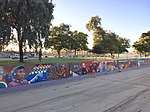North Hollywood shootout

The North Hollywood shootout was a confrontation between two heavily armed and armored bank robbers, Larry Phillips Jr. and Emil Mătăsăreanu, and members of the Los Angeles Police Department (LAPD) in the North Hollywood district of Los Angeles, California, United States on February 28, 1997. Both robbers were killed, twelve police officers and eight civilians were injured, and numerous vehicles and other property were damaged or destroyed by the nearly 2,000 rounds of ammunition fired by the robbers and police.At 9:16 a.m., Phillips and Mătăsăreanu entered and robbed Bank of America's North Hollywood branch. The two robbers were confronted by LAPD officers when they exited the bank and a shootout between the officers and robbers ensued. The robbers attempted to flee the scene, Phillips on foot and Mătăsăreanu in their getaway vehicle, while continuing to exchange fire with the officers. The shootout continued onto a residential street adjacent to the bank until Phillips, mortally wounded, succumbed to a self-inflicted gunshot wound; Mătăsăreanu was incapacitated by officers three blocks away and subsequently bled to death before the arrival of paramedics more than an hour later. Phillips and Mătăsăreanu are believed to have robbed at least two other banks using similar methods for entry past "bullet-proof" security doors, taking control of the entire bank, and firing weapons illegally modified to enable fully-automatic fire. They were also suspects in two armored car robberies.Standard issue sidearms carried by most local patrol officers at the time were 9mm pistols or .38 Special revolvers; some patrol cars were also equipped with a 12-gauge shotgun. Phillips and Mătăsăreanu carried Norinco Type 56 rifles (a Chinese AK-47 variant), a Bushmaster XM-15 Dissipator with a 100-round drum magazine, and a Heckler & Koch HK91 rifle, all of which had been illegally modified to be select-fire capable, as well as a Beretta 92FS pistol. The robbers wore homemade body armor which successfully protected them from handgun rounds and shotgun pellets fired by the responding officers. A law enforcement SWAT team eventually arrived with higher-caliber weapons, but they had little effect on the heavy body armor used by the two perpetrators. The SWAT team also commandeered an armored car to evacuate the wounded. Several officers additionally equipped themselves with AR-15s and other semi-automatic rifles from a nearby firearms dealer. The incident sparked debate on the need for patrol officers to upgrade their firepower in preparation for similar situations in the future.Due to the large number of injuries and rounds fired, equipment used by the robbers, and overall length of the shootout, it is regarded as one of the most intense and significant gun battles in U.S. police history. Combined, the two men had fired approximately 1,100 rounds in total, while approximately 650 rounds were fired by police. Another estimate is that a total of nearly 2,000 rounds were fired collectively.
Excerpt from the Wikipedia article North Hollywood shootout (License: CC BY-SA 3.0, Authors, Images).North Hollywood shootout
Laurel Canyon Boulevard, Los Angeles
Geographical coordinates (GPS) Address Nearby Places Show on map
Geographical coordinates (GPS)
| Latitude | Longitude |
|---|---|
| N 34.191944444444 ° | E -118.39638888889 ° |
Address
Laurel Canyon Boulevard
Laurel Canyon Boulevard
91606 Los Angeles
California, United States
Open on Google Maps





